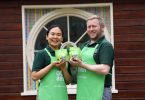“Our vision is really ‘endurance’ – John Hayes
There must be a reason for Ireland being this year’s choice of venue for Brown-Forman’s annual Board Meeting – and there is: the Slane Whiskey Distillery, B-F’s new €50 milllion baby.
John Hayes, Senior Vice President and Chief Marketing Officer for Brown-Forman, is over for this meeting in Dublin and explains its import.
“It’s a big deal for us in that the Board rarely leaves the US as a board,” he tells me.
They’d held a Board Meeting in Mexico when Herradura tequila was acquired and went to St Petersburg to view the Finlandia business four or five years ago. Finlandia’s Russia’s top imported brand.
Over here to view its latest acquisition, Slane Irish Whiskey,
Brown-Forman’s a significant player in the global drinks industry – not nearly as large as Diageo or Pernod Ricard, granted, but it’s no small potatoes either.
It leads the American whiskey business globally through Jack Daniels and Woodford Reserve. Over the last 10 years it’s begun to diversify its portfolio into whisk(e)ys and tequilas, first by getting into the tequila business – “It’s a rapidly developing category” – and in the last two years into whisk(e)y by acquiring the Glenglassaugh, GlenDronach and Glenrioch Distilleries in Scotland and Slane Irish Whiskey here.
“We’re still an American-owned company with majority ownership held by the Brown family” explains John who, as Chief Marketing Officer, is responsible for all B-F brands but JD, “and the company has been around since 1870.”
And Brown-Forman has been here in Ireland in one way or another almost since Prohibition. To illustrate this he outlines the company’s history here.
“We were the exclusive importer of Bushmills into the US until the late 80s and as owners of Southern Comfort we’d our own facilities here in Dublin, Clintock, which blended and bottled Southern Comfort for all Europe from the 80s to the 2000s.”
About 12 to 15 employees were based here in Ireland and the company has been a shareholder – one of three alongside Moet Hennessy and Bacardi – in Edward Dillon & Company for at least 15 years.
Changing times
In the 30 years John’s been coming here the licensed trade has obviously changed a great deal.
“Thirty years ago it was very much the traditional Irish pub scene,” says John, “There were thousands of them with a very strong focus on beer – and one beer in particular! Today we see pubs which have weathered the cyclical economic troubles over the years. These have had their impact on the on-trade. And the licensing legislation too has changed over the years. This is what has challenged the Irish pub trade.“
John’s been coming here more often in last two or three years and has seen a shift to the modern pub scene which manages to blend some of the old with some of the new.
“The beer occasion in pubs is not so much” he believes, “but now but there’s more opportunity for spirits and cocktails and together it’s a very exciting time for Irish pubs.
“Craft beers and craft gins can be found in today’s Irish pub and this can be linked to the fact that pubs are less about just drinking, but are now more food-oriented.”
Brexit concerns
John takes a stoic approach to the downstream effects of Brexit.
“We’ve a presence in 160 countries around the world and there are always changes, both macro-economic and political,” he says, “They’re all challenges that we have to deal with so if Brexit happens we’ll deal with it. It’s certainly something we’ll be watching out for and hoping for a pro-business environment, but there’s nothing we can really do about it other than lobby for our own interests through it. But we’d be a very small voice in the world of Brexit.”
Global spirits market
Globally, spirits are in a good place.
“We’re in a good business,” he concurs, “Spirits have been growing globally by roughly 3% per year in volume for the last five years, but look at the whisk(e)y market and it’s in the 5-6% range.”
He reels off the sub-figures for Scotch: “Single Malt scotch is growing at 6-7% globally as opposed to blended, the majority of which is growing at around 1%.
“But the fastest-growing whiskeys in the world are American and Irish – both are growing globally at about 10%, so that’s twice the rest of whiskey category.
“The Irish whiskey category has really developed and that’s why we’re getting into it – the US is responsible for 45% of Irish whiskey’s value.”
After a decline of many years, American whiskeys are once again doing incredibly well in the US.
“There’s been a resurgence in the past five years, so we’re benefitting from that,” he says, “Now you’re seeing a lot more American whiskeys gaining popularity all over the world including China and Tiawan.”
Across the Pacific, Asia’s imported spirits market is but a tiny fraction of the overall spirits market there, but it’s growing and opportunity lies there.
“I was in Shanghai at the ‘Whisky L’ exhibition and it could be seen there that the Chinese are developing a taste for whiskey.
“Japanese whiskey is growing again too – and really gaining popularity around the world – so much so that they’ve run out of stock.”
Other spirits too are having a field day.
“Tequila’s experiencing double-digit growth in the US which is still the largest tequila market in world,” he explains, “The category is dominated by Mexico and the US, but it’s now beginning to develop outside the US which we’re excited about.
“Gin is exploding on the super premium front, primarily through Hendricks but also through the hundreds of brands in the local craft gin space.”
In Australia he went to a ‘gin bar’ and counted over 200 gins from Australia or New Zealand alone on the gin menu.
“Gin’s an exciting category, mostly in Europe and the US, not so much in Asia.
“In the US gin as a category is only up 1% because the old value brands of gin are not doing that well but at that high end, it’s still fairly niche, particularly in the on-trade – and with the whole mixology cocktail culture today it’s being led mostly by the bartenders doing a lot of experimenting in gin.”
He’s quick to give Grants credit for almost single-handedly revitalising the gin category through its unique innovation for a cucumber-based gin.
Spirits and the consumer
John has also had a chance to observe consumer trends in the US, the UK and in Ireland.
“Between the US, the UK and Ireland there’s a great interest in craft or local brands in certain categories as well as experimentation in flavours via the cocktail culture,” he’s noticed, “At the same time we must recognise the traditional bar scene. I think the similarities are out there in that on-premise space, whether in beer or even wine and spirits. People are looking for more variety and options.
“In this respect, we’ve a giant within our company in Jack Daniels, a powerhouse brand still doing very well, but we’re aware of how you balance a big brand with the people’s desire for small and local. So we’re launching Jack Daniels Rye this month, the first new whiskey grain bill in a long time.”
With such developments he’s confident that Brown-Forman’s changing with the times and managing its portfolio with the times too.
“Woodford Reserve, for example, is considered by many a a new small craft-type bourbon.”
Of course the company also looks to the future, one it views with that confidence.
“We’ve a saying that our ‘vision’ is really ‘endurance’,” he summarises, “We’re predominantly a family-owned company that intends to be around forever. You can’t separate B-F from the family and they’ve a long-term view that in order to endure you have to grow, you can’t stand still.
Slane would be the most recent example.
“We’re very proud of our significant investment in Ireland on the grounds of Slane Castle, famous worldwide for Rock’n Roll concerts and with Irish whiskey’s growth at the moment we believe we can bring our whiskey-making ways proudly into the Irish whiskey category – so, yes, we’re very excited about this Slane Whiskey opportunity.”
And we both agree that they’re probably just as excited up in Slane.








